
It’s a Gas: Nitrous Basics for Beginners
If you’re looking for instant power on demand, then bolting a nitrous oxide kit to your car might be something for you to consider. Nitrous Oxide—sometimes known as laughing gas, nitrous, or NOS, is the chemical compound N2O.
When you heat nitrous oxide to around 570 degrees, it splits into separate molecules of oxygen and nitrogen. What this means is that when nitrous oxide is injected into an engine that is running, the splitting of the molecules creates more oxygen than the engine can use during combustion. Because you now have more oxygen, you can also inject more fuel. Adding more fuel and oxygen to a given engine, allows the same engine to produce more power. Nitrous oxide is one of the simplest ways to provide a significant horsepower boost to any gasoline engine. Nitrous Oxide also has another effect that improves performance. When it vaporizes, it provides a significant cooling effect on the incoming air. When you reduce the incoming air temperature, you increase the air’s density, and denser air makes more power.
Since a 5.7-liter engine (that’s a 350 for you old-school guys), running at 4,000 rpm consumes roughly 2-3/4 gallons of air every minute (compared to about .005 gallons of gasoline), it would take a tremendous amount of Nitrous to continuously run a car. Therefore, each 10-pound bottle normally carries only a few usable minutes of nitrous oxide, and the driver uses it very selectively by arming the system only when needed.
There are two main types of nitrous oxide systems – dry and wet. A dry nitrous system only controls the delivery of the nitrous oxide, while the fuel is delivered via the existing OE fuel system. A dry kit is usually installed on late-model vehicles with a throttle body. The extra fuel required by the addition of the nitrous is gained by either increasing the fuel-delivery pressure, or by extending the time at which the fuel injector is held open. Single-injector dry systems are sometimes referred to as a “dry manifold system”, because the additional fuel that is required with the use of Nitrous does not pass through the intake manifold as it does with a wet system. A dry system is good for about a 100 – 150 horsepower increase. The mounting location for the nozzle is typically in the air inlet tube at a point about 2-6 inches before the throttle body.
A wet single-point nitrous system has a nozzle that introduces both the fuel and nitrous into the engine. A wet kit is used on carbureted and EFI cars. Typically, on an EFI-equipped car, this nozzle is also mounted before the throttle body, and the introduction of fuel and nitrous to the intake causes the intake manifold to become “wet” with fuel. In a carbureted application, this is done via a plate that is installed under the carburetor. Since the intake on many late-model engines are designed to operate in a dry condition, adding fuel to the flow of air through the intake can sometimes result in fuel distribution problems. This is because dry intakes are designed to only move air, which will travel through smaller openings and tighter turns with less pressure. Wet nitrous systems have capability to produce more power than dry systems, but in many cases, can be more expensive and difficult to install. This is due to the process of tapping into the fuel delivery system, many of which are high pressure (20-50 psi).
If you are trying to decide which kit is best for you, just like everything else, it all depends on the application. A wet kit is ideal for both normally aspirated engines as well as forced induction applications. A dry kit is excellent for normally aspirated combinations that have a return style fuel system. They are very easy to install and are a great first-time nitrous system. It is not recommended that dry systems be used on forced induction engines.
A multi-point system is the type of nitrous system that can produce the most power. This is due to the placement of the nozzle in each runner, as well as the ability to use more and higher capacity solenoids. Wet multi-point kits can be used in two, three, or even four stages. These systems are also the most complex and expensive of nitrous systems, requiring significant modification to the engine, including adding distribution blocks and plumbing for each cylinder. These systems are typically used in racing applications. A more recent improvement on the staged concept is the progressive delivery system, which allows a system to deliver a smoothly-progressive increase in power, which is adjustable to suit user requirements.
When nitrous is injected into an engine, it is imperative that the timing has been properly set. Running Nitrous Oxide requires that the timing be backed off (retarded), and a good rule of thumb is to retard the timing 1-1/2 to -2-degrees for every 50 horsepower of added nitrous. The reason you retard timing with nitrous, is that the air charge becomes more oxygen dense, and this results in the air/fuel mixture burning at a much higher rate. This causes peak cylinder pressure to happen much earlier. Retarding the timing will ensure that peak cylinder pressure occurs at the point that is most beneficial to making power.
Adding Nitrous to your engine also forces you to pay attention to the spark plug heat range, reach, and gap. It is widely accepted that lowering the heat range of your spark plugs one heat range for every 100 horsepower of nitrous added is needed. It is also best to use a non-projected-tip spark plug. Projected plugs allow a greater portion of the electrode to be exposed to combustion gases, and that can cause detonation. The spark plug gap also plays an important part in nitrous-fed engine performance. The increased cylinder pressure created by the additional nitrous and fuel, makes it harder for the spark to jump the gap between the ground strap and the electrode, causing misfires and a loss of power. Ideally a gap between .025 and .035-inch should be used on high horsepower applications where an inductive style ignition system is utilized. Engines equipped with capacitive discharge ignition systems may use gaps larger than .035-inch. It’s very important to learn how to read the plugs after a pass. A plug can tell you a lot of what is happening in the combustion chamber.
As with any modification, the use of Nitrous Oxide carries with it concerns about the engine’s reliability and lifespan. Due to the increased cylinder pressures, the engine as a whole is placed under greater stress, and an engine with components not able to cope with the increased stress from the nitrous system can experience minor—or even major, engine damage, such as cracked or destroyed pistons, bent connecting rods, or even damage to the crankshaft. Even if the engine is up to the task, severe damage can occur if a problem presents itself in the fuel system. For example, let’s say that the engine’s fuel supply was diminished – even for a brief moment, this would cause the engine to run lean by whatever degree the fuel delivery was reduced, and this could lead to engine knock or detonation. Depending on the engine, this may only need to occur for a matter of seconds before major damage occurs. It is recommended that some sort of sensor or controller be incorporated into the ignition system to disable the nitrous system when spark knock is detected by a knock sensor. It is also recommended that high-octane Premium fuel be used to avoid detonation.
Reading Spark Plugs form a Nitrous Oxide Injected Engine:
A. Correct Timing, Mixture, and Spark Plug Heat Range
Ground strap retains a “like new” appearance. Edges are crisp, with no signs of discoloration. Porcelain retains clear white appearance with no “peppering” or spotting.
B. Excessively Rich Mixture
Porcelain may be fuel stained, appearing brown or black. In extreme cases, ground strap, electrode, and porcelain may be damp with gasoline, or smell of fuel.
C. Detonation
Edges of the ground strap may become rounded. Porcelain has the appearance of being sprinkled with pepper, or may have aluminum speckles. During heavy detonation, the ground strap tip may burn off. This can result from excessive ignition timing, too hot of a spark plug, or inadequate fuel octane.
D. Excessively Lean Mixture
Edges of the ground strap may become rounded. Under moderate overheating, the tip of the ground strap can discolor, usually turning purple, or the entire ground strap can become discolored.

This Zex Blackout Wet Nitrous System for EFI applications is designed to provide anywhere from 75-125 additional horsepower to your engine. The kit can be installed on an engine that is stock, or even one that is turbocharged or supercharged in around two hours. All necessary components come with the kit, including tuning jets, required fuel fittings and a Nitrous Management Unit that contains solenoids, filters, and electronics. This nitrous system’s Active Fuel Control automatically adjusts fuel delivery to compensate for changes in nitrous-bottle pressure, so that your engine never runs too rich or too lean while spraying the nitrous. In addition, the system also offers an electronic TPS switch for reliable system activation at wide open throttle.
Since the first racer started using Nitrous Oxide to increase the power of his car, NOS – Nitrous Oxide Systems was there. This Wet, Plate system kit is designed specifically for cars with carbureted intakes. The plate mounts between the carburetor and the intake.
There are a few basic characteristics about spark plugs that you need to know so that you can make an intelligent choice about what is the correct spark plug for your nitrous-equipped engine. Using a projected-tip spark plug can produce a misfire condition after just a few seconds of using nitrous. The misfire is not due to using an improper heat range, but rather, the misfire occurs because the ground strap of the spark plug starts glowing because it is too long to dissipate the extra heat that is being produced by the nitrous-accelerated ignition burn. The proper way to fix this condition is to replace the plugs with one that has a nose that does not “project” as far into the cylinder. If you simply introduce a spark plug with a colder heat range but still having a projected tip, you might still have a misfire problem.
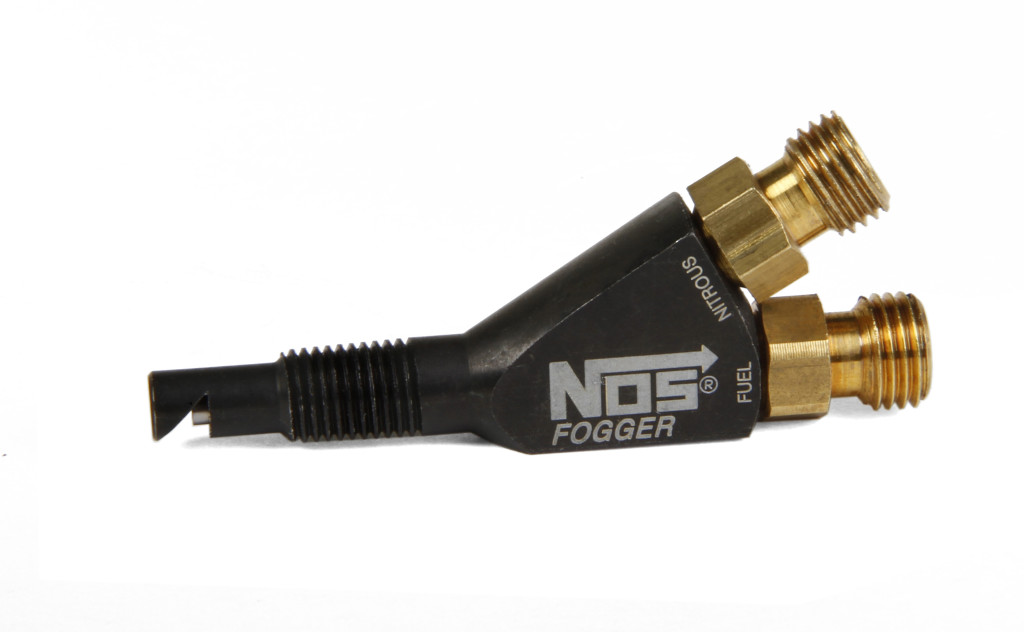
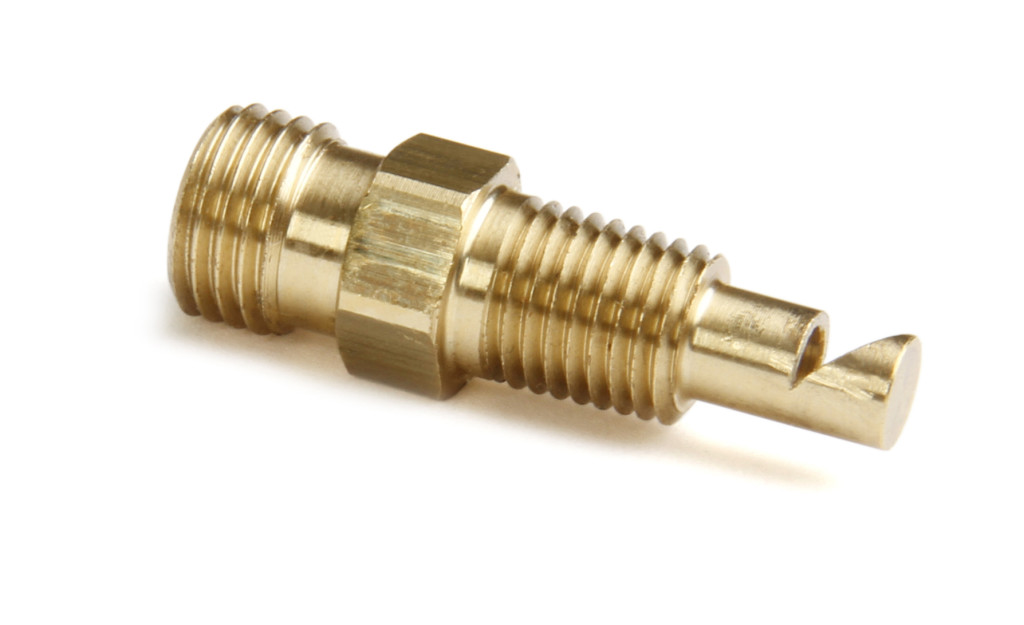 There are two types of nitrous nozzles—wet and dry. The gold nozzle is a dry nozzle and only is capable of shooting nitrous into the engine. The black nozzle is a wet nozzle, which sprays both nitrous and fuel into the engine. Dry nozzles are often used for smaller shots of nitrous. Some people prefer to use dry nozzles, because they feel that they can control the fuel better through the injectors with advanced engine management systems, and can tune the vehicle better through this method. Wet nozzles are used to add fuel and nitrous and are used for both big and small shots of nitrous. Most normal nitrous users use wet shots on bigger and direct port nitrous systems.
There are two types of nitrous nozzles—wet and dry. The gold nozzle is a dry nozzle and only is capable of shooting nitrous into the engine. The black nozzle is a wet nozzle, which sprays both nitrous and fuel into the engine. Dry nozzles are often used for smaller shots of nitrous. Some people prefer to use dry nozzles, because they feel that they can control the fuel better through the injectors with advanced engine management systems, and can tune the vehicle better through this method. Wet nozzles are used to add fuel and nitrous and are used for both big and small shots of nitrous. Most normal nitrous users use wet shots on bigger and direct port nitrous systems.
With a plate-type nitrous system, you have a plate that houses two tubes (spray bars), one for fuel, and one for Nitrous, or a plate with holes around the perimeter. Both plates mount between your carburetor and intake manifold, and injects the nitrous into the incoming air stream.
Images courtesy of Holley




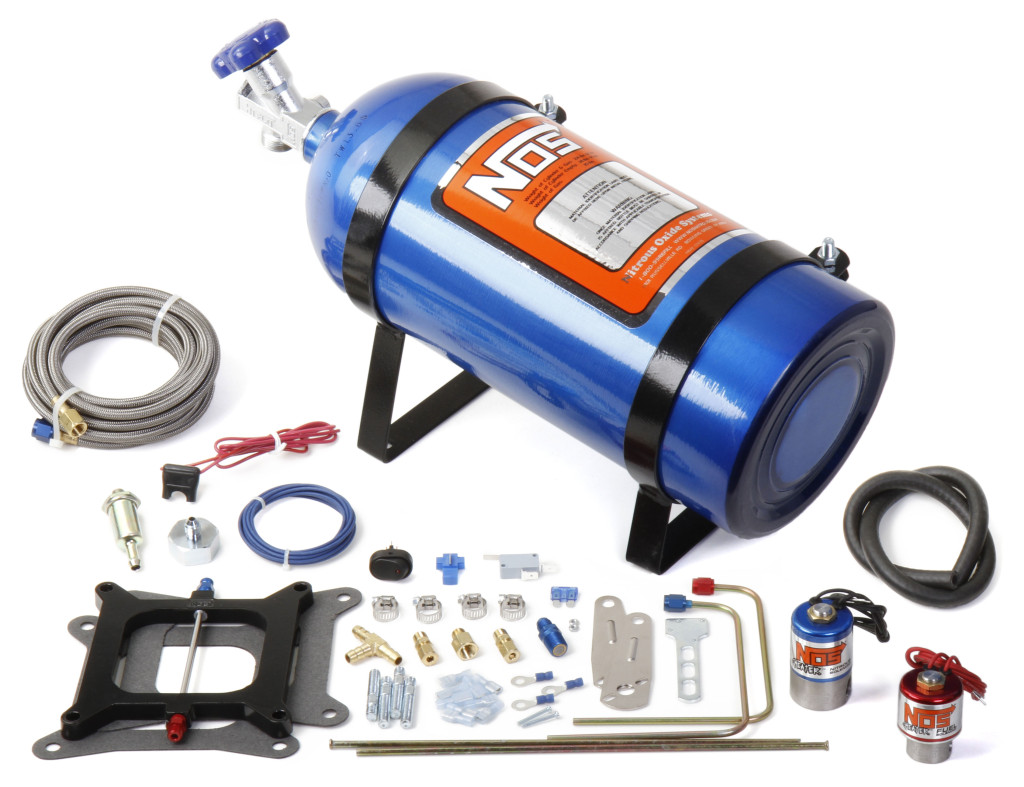

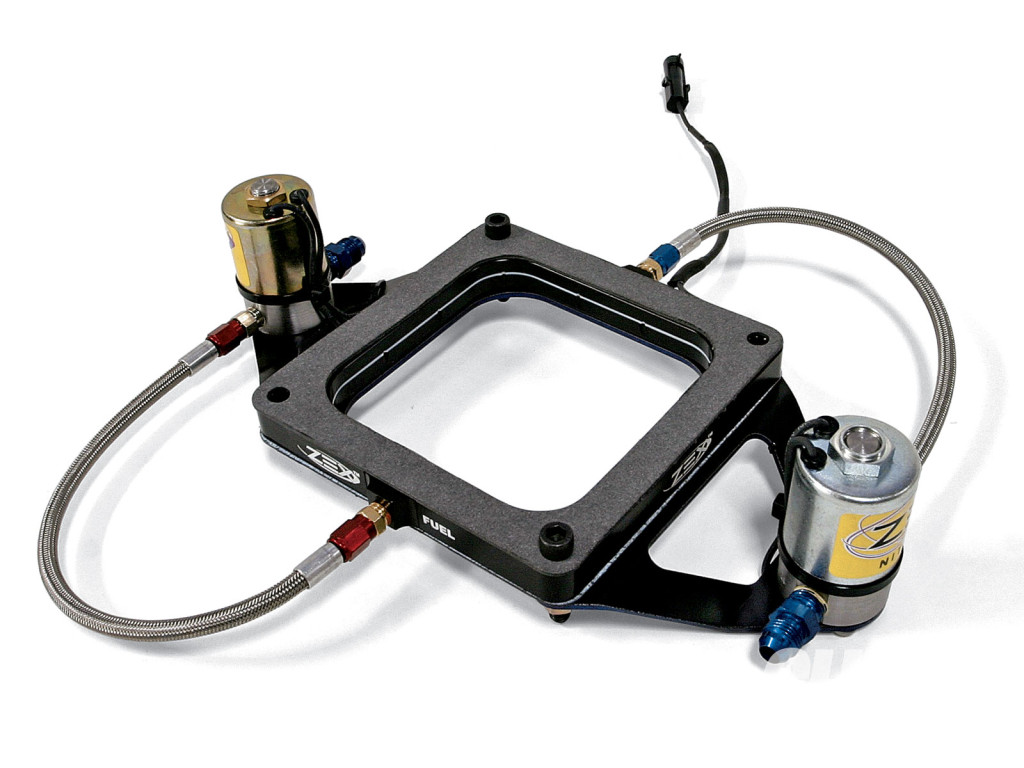
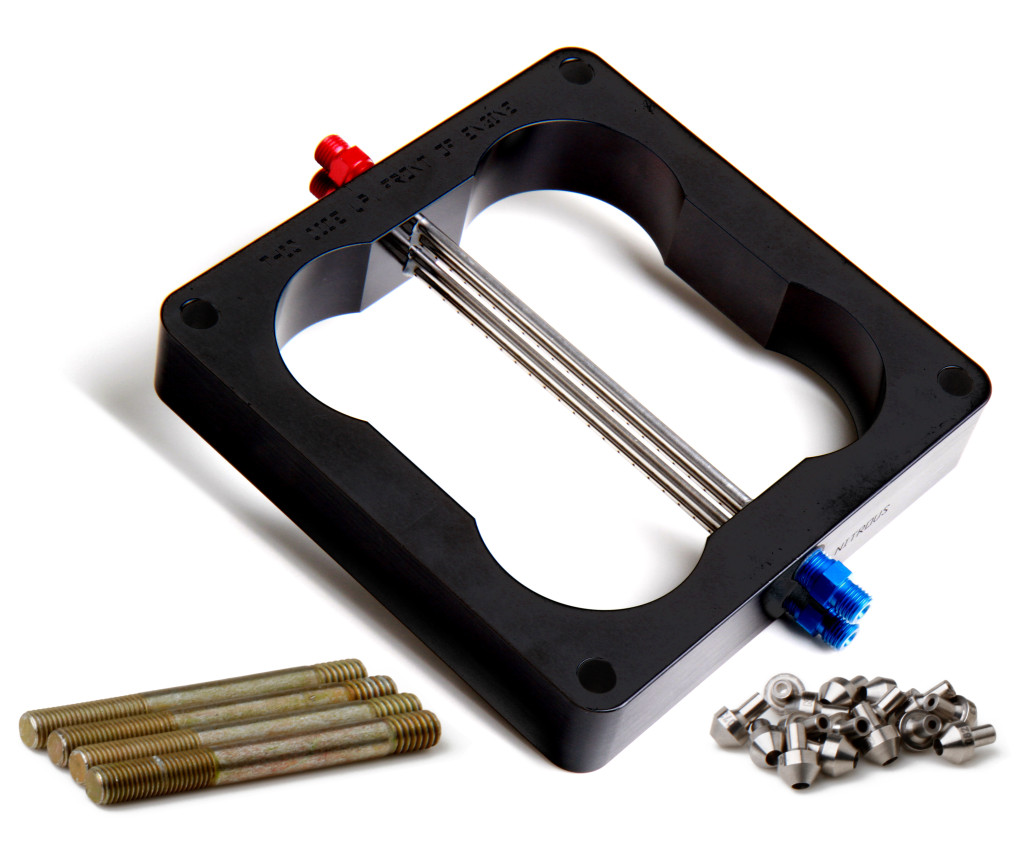
I think you meant 0.05 gallons of gas, not 0.005, otherwise you would get 200 mpg!